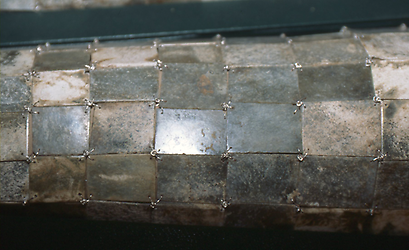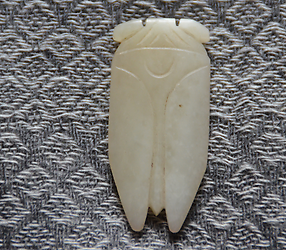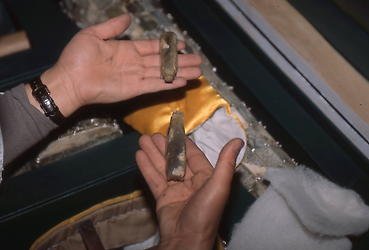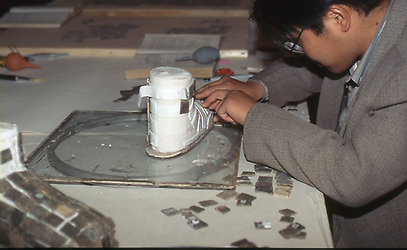Restoration of an antique funeral dress made of Jade during the Han-Dynasty from the Guishan emperor's - grave in Xuzhou/Jiangsu#
By
After the spectacular discovery of the Terracotta Army of the First Emperor Chin Shi Huangdi near Xian in China, further sophisticated grave sites of later dynasties were excavated, archaeologically explored and finally made accessible to the public. Armies and replica of the court of the dead emperors were found in grave sites. Having only a sculpture-size of about one-third of the terracota warriors of Xian, the grave finds, nevertheless, give ideas about the concepts of afterlife in ancient China.
According to Chinese understanding the human being has two souls. One enters the human being at conception, the other at birth. When dying, the two souls separate from each other. One rises into the Palace of the Jade Emperor in heaven, the other descends to the grave palace underground. It has to be furnished with needs for life in the grave. For this reason the descendants of the dead have to continue to make sacrifices. Otherwise, the unsatisfied spirit will visit the world of the living and cause hardship.
Painted warriors made from terracotta protect him. He is entertained by women, musicians, dancers and jugglers as in his real life. They are exact replicas of really existing persons. Eating and drinking in abundance, kitchens, storerooms, batherooms and sanitary facilities are availabe in the grave sites. They surround the actual grave chamber in which the dead ruler is resting in a sarcophagi. During the Han dynasty the dead bodies were wrapped in a dress made of jade. A few jade dresses have survived and can be admired in Chinese museums. Especially the excavations in the Chinese city Xuzhou show impressively this special type of clothing an emperor would wear after his death.
The city of Suzhou in Jiangsu Province with its 3,8 million inhabitants is a medium-sized (!) town, but has a rich historical past. There are excavations dating back to the time of the almost legendary first dynasties Chou and Shang. In ancient times the city was called Pengcheng. Liu Bang, the first Emperor of the Han dynasty was born here. Suzhou was part of the kingdom Chu, belonging to the Han emperors as a vassal state. Important military leaders and members of the clan of Lui were appointed and ruled the region. They were allowed to hold the title king. Actually, they developed an almost imperial pomp in the culture of funerals and sepulcrals. Starting with the third generation, an initially high economic prosperity was followed by a gradual decline because of uprisings against the central power. Especially as a consequence of the rebellion against Emperor Liu Wu, some grave sites remained unfinished, some were not completely furnished and precious metals were partly replaced by cheaper replacement materials.
The Turtle Mountain (Chin. Guishan) situated on the outskirts of Xuzhou is the most important archaeological site next to the lion-mountain grave and yet another one, the grave of the sixth king Chu Liu Zhu (128-116 BC) and his wife Princess Tou Wan. The subterranean funeral palace was discovered in 1968. The exploration of this unique site was possible only after the so-called Cultural Revolution. The grave site with 15 rooms had been already opened and plundered by grave robbers in ancient times. Nevertheless, the remains, consisting of ceramics, small sculptures and devices made of bronze, jade and other materials as well as parts of two jade dresses and a sarcophargi decorated with jade give us an idea about the original furnishing.

Photo: G. Jontes, under CC BY 4.0

Photo: G. Jontes, under CC BY 4.0

Photo: G. Jontes, under CC BY 4.0
The Administration of Xuzhou recognized the cultural value of the exploration. At the beginning of the 80s of the 20th century they started to open the sites for tourism – first for own citizens and then for Western visitors. The museum of the explorations (Xuzhou Bowuguan)and the museum of abrasion of stones in a nice lanscape are presented to the visitors. A very professional team of archaeologists and conservators looks after the finds which can be seen also in exhibitions in Europe. In 1998 an exhibition took place in the Austrian city of Leoben: The author of this essay acted as curator.
A special showcase of this exhibitition was a jade burial dress that was supposed to protect the Emperor in his afterlife and his physical existence.
Jade (chin. yù) is, from a mineralogist point of view, not a mineral as such, but a mixture of jadeite and nephrite. The Western word jade comes from the Spanish “piedra de ijada”, meaning “kidney stone”. It is called Nephrit (greek nephros “kidney”) because of the shelly, kidney-shaped fracture of the mineral. Jade is very hard but was already processed with simple bronze devices during the Xia Dynasty in the 3rd millennium BC. At that time this was an unbelievable artisanal achievement. Jade is found in many shades, ranging from transparent white to black, with many color variations. The most precious (chin. wang yu) is the emerald Emperor's jade. It comes from Burma / Myanmar. Its exquisitely beautiful shade comes from tiny chrome deposits. It should not come as surprise that the Chinese character for jade is the pictogram for king with only a slight variation!

Photo: G. Jontes, under CC BY 4.0
Most probably, jade was regarded as very hard and undestroyable and therefore as suitable to prevent the decay of bodies. Jade was also thought to combat fatigue in the living. Ritual devices ware crafted, such as the famaous Bi-Discs for oracle purposes, thus creating a veritable jade cult.
The dragon as motif of the sacred art and the Empire was often crafted from jade. Even in recent Chinese cultural history jade statues are found, such as the well-known statue of the reclining Buddha in the Jade Buddha Temple in Shanghai. Today jade is primarily processed to jewelry, finding an increasing demand in the West. The mineral occurs also in pre-Columbian Central America. Mayas and other indigenous civilizations used jade among others as ceremonial objects and masks.
As already mentioned, jade dresses were only used in the funeral cult in the Han period. Up to 4000 rectangular thin plates were put together. The dress was made to measure. The plates were fixed with wire made of gold, silver or bronze. The wire was threaded through small holes drilled near the corner of each piece. Approximately up to 1,5 kg thin gold wire was needed for one jade dress. The process of manufacturing is comparable with the medieval dresses made of iron rings and worn by warriors in the West. The whole body including the face was completely covered and wrapped by such a dress.

Photo: G. Jontes, under CC BY 4.0

Photo: G. Jontes, under CC BY 4.0

Photo: G. Jontes, under CC BY 4.0

Photo: G. Jontes, under CC BY 4.0
All body openings under the jade dress were closed. The mouth was closed with a cicada of jade and the anus was closed with a small pig of jade, representing the symbol of luck.

Photo: G. Jontes, under CC BY 4.0

Photo: G. Jontes, under CC BY 4.0
The jade dresses failed in preventing the decay. The body of the dead was not even mummified. Only dried-out remnants of bodies were found.

Photo: G. Jontes, under CC BY 4.0

Photo: G. Jontes, under CC BY 4.0
Grave robbers were not interested in jade dresses with the exception of metal wires and artificial jade objects. Thus, parts of jade dresses were found on the ground in funeral sites. A tiny part of a wire forgotten by robbers was made of bronze and covered with a thin layer of gold foil. This is an indication that at that time the decline of the Liu family had started because of military and political circumstances of the late Western Han. The Liu family had to economise. A coffin was reconstructed from the scattered parts of jade. Except for the coffin found in Xuzhou only one more of its kind was found in the province of Hebei.

Photo Museum Xuzhou, under CC BY 4.0

Photo Museum Xuzhou, under CC BY 4.0

Photo: G. Jontes, under CC BY 4.0
The unfinished chambers in the grave of Guishan show us the work of the stonecutters. After all, the long corridor-like access area was closed by huge blocks of stone. The robbers succeeded in making holes at the edges to thread ropes through the holes and to pull out the blocks. This also means that strong men were needed for this work. This work can be compared with the work of the ancient grave robbers of the tombs of the Pharaohs, where everything was plundered.

Photo: G. Jontes, under CC BY 4.0
In 1997/98 the restoration and compostion of the jade burial dress of King Chu Liu Zhu started. Putting together about 4000 jade plates was a difficult puzzle. Patience is one of the main virtues of restorers. They resembled in patience their ancestors who had chiseld out these small parts from very hard stones. By the way, this kind of jade came form the province of Hetian. Thus, this material was travelling a long way as trading commodity.

Photo: G. Jontes, under CC BY 4.0
To reconstruct the burial dress, the individual parts of the body were prefabricated from modern materials and the jade parts put on once the fit was clear. It took two years to recontstruct the dress. The result was truly perfect: The funeral dress was presented to the public in museums and sent on exibition tours. What would emperors think that their imortality was achieved in this fashion?
The funeral dress of Princess/Queen Tou Wen was reconstructed from scattered parts already in the 70s of the 20th century. It was presented on the occasion of the exhibition „Archaeological Treasures from the People's Republic of China" in 1973 in Paris and one year later in Vienna. The dress consists of 2160 jade plates. The plates were fixed with silk-wrapped iron wire, the chest part was connected with linen cloth. Certain parts consisted of royal gold, 703 grams of which had been drawn to wire.

Photo: G. Jontes, under CC BY 4.0

Photo: G. Jontes, under CC BY 4.0

Photo: G. Jontes, under CC BY 4.0

Photo: G. Jontes, under CC BY 4.0

Photo: G. Jontes, under CC BY 4.0

Photo: G. Jontes, under CC BY 4.0

Photo: G. Jontes, under CC BY 4.0